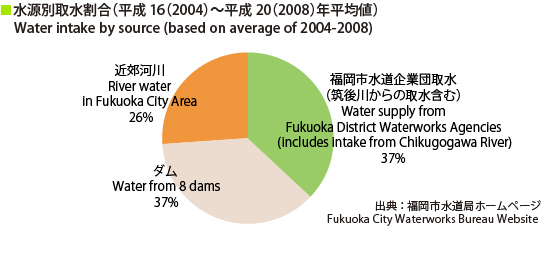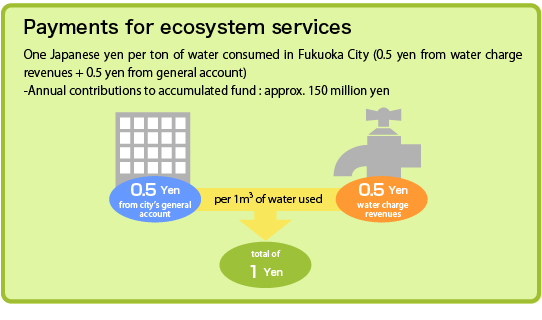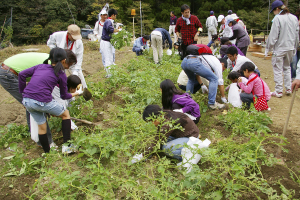
Top page > Water resources > River basin tariffs in Fukuoka City
•Year started: 1997
•Location: Fukuoka City, 17 local governments in Oita & Kumamoto Prefectures
•Actor: Fukuoka City Waterworks
Fukuoka City is the only major city in Japan without a first-class river flowing through the city. It has relied on intake from the Chikugogawa River running outside the city, seawater desalination and dam developments in and outside the city (five out of eight dams being located in neighboring municipalities).

However, faced with the problems of an aging and declining population and forestry workforce as well as stagnant wood prices, the water source forests have become degraded, therefore impairing their water recharge functions to the extent that maintaining a stable water supply has become jeopardized.
Against this backdrop, Fukuoka City established the Fukuoka City Foundation for Water Resource Preservation Projects in 1997. It was built upon Toyota City's pioneering example[1] and reserved 1 yen – 0.5 yen from water charge revenues and 0.5 yen from the city's general account - per ton of water consumed in the city from 1997 through 2006 in a water source conservation fund (fund balance approximately 1.06 billion yen as of March, 2009). It currently allocates 100 million yen from the fund annually for the projects named below.

The fund is used to improve water source forests and to implement exchange programs and collaborative projects with headwater areas in order to improve water recharge capacities, revitalize headwater areas and enhance partnership and mutual cooperation among local governments located upstream and downstream. Furthermore, the city promotes programs that seek to raise awareness among the citizens of Fukuoka, located downstream, of the current status of the city's water sources and the importance of water.
•Improving water source forests
Fukuoka City improves water source forests in catchment areas[2] near the dams developed within the city to source drinking water only, namely the Magaribuchi, Sefuri and Hase Dams, by planting broad-leaved forests, clearing underbrush and tree thinning. For local dams, the Waterworks Bureau is engaged in efforts to purchase forests in catchment areas in order to enhance water recharge capacities and prevent water contamination from excessive development. As of fiscal 2008, approximately 30 percent (505 hectares) of the catchment areas of the three local dams has been bought by the city. For the appropriate management of these forests, the city formulated the Fukuoka City Water Source Forest Management Plan covering 60 years in fiscal 2004.
1) Magaribuchi Dam: The water source forest stretches over approximately 1,000 hectares, 40 percent of which is owned by Fukuoka City. Planted forests account for 60 percent, another 60 percent of which are young trees aged under 40 years.
2) Sefuri Dam: The water source forest covers an area of approximately 510 ha, approximately 50 percent of which is privately owned. Fukuoka City possesses only 4 percent. Seventy percent of the forest has been planted.
3) Hase Dam: The water source forest covers an area of approximately 130 hectares. Fukuoka City owns approximately 40 percent. Planted forests cover approximately 30 percent of the area and 80 percent of the entire forest area are aged trees of over 40 years.
Water source forests located outside of the city are managed with the cooperation of local governments.
•Exchange program with water source area
In pursuit of fostering close relationships with water source areas, Fukuoka City invites its citizens to take part in silvicultural management activities and events to dig for potatoes or make rice-cakes with local people. It also offers grants (up to one-half of total costs with a maximum of 500 thousand yen) in support of civil activities to plant trees and clear underbrush as well as other interactive programs.

Photo:Digging for potatoes ©Fukuoka City Waterworks Bureau
•Contributions to Fund for River Basin-based Partnership among Municipalities
in the Greater Fukuoka Area[3]
Fukuoka City contributes to a fund established by the Partnership for Public Administration in the greater Fukuoka area to cooperate with neighboring local governments in shared activities in water source areas.
[1] Toyota City Fund for Water Source Recharge Project collects an add-on of 1 yen per each ton of water consumed to be reserved in a fund designated for water source conservation and water quality management. Consumers can witness the odd pricing on their water bills and therefore be conscious of the fact that they, as beneficiaries, are shouldering a part of the water source conservation activities. Fukuoka City's approach differs from that of Toyota City in that it considers the costs for watershed protection inclusive of the water tariff instead of imposing an extra fee.
[2] Extent or area of land where rainwater drains downhill into a dam body of water.
[3] Established in 2005. Nineteen municipalities of the greater Fukuoka area jointly engaged in projects for common water sources or river basins. Funding is provided for programs to strengthen ties with inhabitants of water source areas through recreation events and water source management projects as well as grants for environmental NPOs. Sixty million yen is collected annually (30 million yen is accumulated and 30 million yen is allocated to projects), 40 million yen of which Fukuoka City contributes. Fukuoka City Fund for Water Source Recharge Project accounts for 32 million yen and the remaining 8 million yen is provided from the city's general account.
•References
·Fukuoka City Waterworks, Fostering a Rich Water Source Forest: The Fukuoka City Fund for Water Source Recharge Project (in Japanese only)
·Kajisaka, Yasuhiko (2008) Managing Water Source Forests and Liaison with Water Source Areas: Fukuoka City Fund for Water Source Recharge Project in Kurachi, Koichi eds. Can Forest Environmental Taxes Save our Forests? : abstracts from the Twentieth National Conference on Conserving Japan's Forests and Nature, Seto City, Japan: The Tokyo University Forests (in Japanese only)
•Special thanks to
Fukuoka City Waterworks Bureau(River Basin Cooperation Division)


